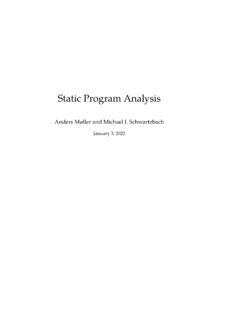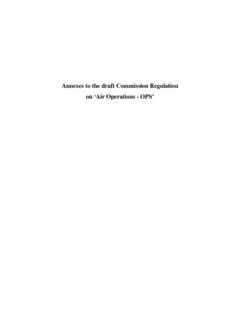Transcription of Solar Position Algorithm for Solar Radiation ... - NREL
1 Revised January 2008 nrel /TP-560-34302 Solar Position Algorithm for Solar Radiation Applications Ibrahim Reda and Afshin Andreas National Renewable Energy Laboratory 1617 Cole Boulevard Golden, Colorado 80401-3393 nrel is a Department of Energy LaboratoryOperated by Midwest Research Institute Battelle Bechtel Contract No. DE-AC36-99-GO10337 Revised January 2008 nrel /TP-560-34302 Solar Position Algorithm for Solar Radiation Applications Ibrahim Reda and Afshin Andreas Prepared under Task No. WU1D5600 National Renewable Energy Laboratory 1617 Cole Boulevard Golden, Colorado 80401-3393 nrel is a Department of Energy LaboratoryOperated by Midwest Research Institute Battelle Bechtel Contract No.
2 DE-AC36-99-GO10337 Printed on paper containing at least 50% wastepaper, including 20% postconsumer waste Acknowledgment We thank Bev Kay for all her support by manually typing all the data tables in the report into text files, which made it easy and timely to transport to the report text and all of our software code. We also thank Daryl Myers for all his technical expertise in Solar Radiation applications. NOTICE This report was prepared as an account of work sponsored by an agency of the United States government. Neither the United States government nor any agency thereof, nor any of their employees, makes any warranty, express or implied, or assumes any legal liability or responsibility for the accuracy, completeness, or usefulness of any information, apparatus, product, or process disclosed, or represents that its use would not infringe privately owned rights.
3 Reference herein to any specific commercial product, process, or service by trade name, trademark, manufacturer, or otherwise does not necessarily constitute or imply its endorsement, recommendation, or favoring by the United States government or any agency thereof. The views and opinions of authors expressed herein do not necessarily state or reflect those of the United States government or any agency thereof. Available electronically at Available for a processing fee to Department of Energy and its contractors, in paper, from: Department of Energy Office of Scientific and Technical Information Box 62 Oak Ridge, TN 37831-0062 phone: fax: email: Available for sale to the public, in paper, from: Department of Commerce National Technical Information Service 5285 Port Royal Road Springfield, VA 22161 phone: fax: email: online ordering: iii Table of Contents Abstract.
4 V Introduction ..1 Time Scale ..2 Procedure ..3 SPA Evaluation and Conclusion ..12 List of Figures Figure 1. Uncertainty of cosine the Solar zenith angle resulting from and uncertainty in the angle calculation..13 Figure 2. Difference between the Almanac and SPA for the ecliptic longitude & latitude, and the apparent right ascension & declination on the second day of each month at 0-TT for the years 1994, 1995, 1996, and 2004 ..14 Figure 3. Difference between the Almanac and SPA for the Solar zenith and azimuth angles on the second day of each month at 0-TT for the years 1994, 1995, 1996, and 2004..15 References ..16 Appendix Equation of Time.
5 A-1 Sunrise, Sun Transit, and Sunset .. A-1 Calculation of Calendar Date from Julian Day .. A-6 Example .. A-15 C source code for SPA .. A-17 List of Appendix Figures Figure Difference between the Almanac and SPA for the Ephemeris Transit on the second day of each month at 0-TT for the years 1994, 1995, 1996, and 2004.. A-5 List of Appendix TablesTable Examples for Testing any Program to Calculate the Julian Day .. A-7 Table Earth Periodic Terms .. A-7 Table Periodic Terms for the Nutation in Longitude and Obliquity .. A-13 Table Results for Example .. A-15iv Abstract There have been many published articles describing Solar Position algorithms for Solar Radiation applications.
6 The best uncertainty achieved in most of these articles is greater than in calculating the Solar zenith and azimuth angles. For some, the Algorithm is valid for a limited number of years varying from 15 years to a hundred years. This report is a step by step procedure for implementing an Algorithm to calculate the Solar zenith and azimuth angles in the period from the year -2000 to 6000, with uncertainties of The Algorithm is described by Jean Meeus [3]. This report is written in a step by step format to simplify the complicated steps described in the book, with a focus on the sun instead of the planets and stars in general. It also introduces some changes to accommodate for Solar Radiation applications.
7 The changes include changing the direction of measuring azimuth angles to be measured from north and eastward instead of being measured from south and eastward, and the direction of measuring the observer s geographical longitude to be measured as positive eastward from Greenwich meridian instead of negative. This report also includes the calculation of incidence angle for a surface that is tilted to any horizontal and vertical angle, as described by Iqbal [4]. v With the continuous technological advancements in Solar Radiation applications, there will always be a demand for smaller uncertainty in calculating the Solar Position . Many methods to calculate the Solar Position have been published in the Solar Radiation literature, nevertheless, their uncertainties have been greater than in Solar zenith and azimuth angle calculations, and some are only valid for a specific number of years[1].
8 For example, Michalsky s calculations are limited to the period from 1950 to 2050 with uncertainty of greater than [2], and the calculations of Blanco-Muriel et al. s are limited to the period from 1999 to 2015 with uncertainty greater than > [1]. An example emphasizing the importance of reducing the uncertainty of calculating the Solar Position to lower than , is the calibration of pyranometers that measure the global Solar irradiance. During the calibration, the responsivity of the pyranometer is calculated at zenith angles from 0/ to 90/ by dividing its output voltage by the reference global Solar irradiance (G), which is a function of the cosine of the zenith angle (cos 2).
9 Figure 1 shows the magnitude of errors that the uncertainty in 2 can contribute to the calculation of cos 2, and consequently G that is used to calculate the responsivity. Figure 1 shows that the uncertainty in cos 2 exponentially increases as 2 reaches 90/( at 2 equal to 87/, the uncertainty in cos 2 is , which can result in an uncertainty of in calculating G; because at such large zenith angles the normal incidence irradiance is approximately equal to half the value of G). From this arises the need to use a Solar Position Algorithm with lower uncertainty for users that are interested in measuring the global Solar irradiance with smaller uncertainties in the full zenith angle range from 0/ to 90/.
10 In this report we describe a procedure for a Solar Position Algorithm (SPA) to calculate the Solar zenith and azimuth angle with uncertainties equal to in the period from the year -2000 to 6000. Figure 1 shows that the uncertainty of the reference global Solar irradiance, resulting from in calculating the Solar zenith angle in the range from 0/ to 90/ is negligible. The procedure is adopted from The Astronomical Algorithms [3], which is based on the Variations S culaires des Orbites Plan taires Theory (VSOP87) that was developed by P. Bretagnon in 1982 then modified in 1987 by Bretagnon and Francou [3]. In this report, we summarize the complex Algorithm elements scattered throughout the book to calculate the Solar Position , and introduce some modification to the Algorithm to accommodate Solar Radiation applications.
















